
views
Making Red Food Colouring From Beets
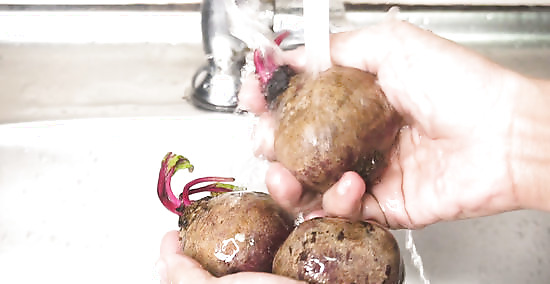
Wash 3 large beets under running water. Since beets are a root vegetable, they often have dirt residue on their skin when you purchase them from the store. To ensure you don’t get any dirt in your food coloring, rinse the beets well under cool running water, and scrub the surface with your fingers or a vegetable brush if you have one. Some varieties of beets are white or yellow on the inside, so make sure you choose red beets for this project. Did You Know? If you can find dehydrated beet powder, you can mix 1 part beet powder with 4 parts water to make red food coloring! Adjust the proportions to get just the color you want.

Trim off the ends, then chop the beets into 1 in (2.5 cm) pieces. Place the beets on a cutting board and cut off the stem and the woody portion on the bottom of each one. Then, slice the beets in half. Cut each half into strips vertically, then make a series of horizontal cuts so you end up with square pieces that are approximately 1 in (2.5 cm) wide all the way around. Remember to be careful when you’re using a knife! Grip the knife with your dominant hand, then hold the vegetable securely with your non-dominant hand, curling your fingers inward like you’re making a claw. That way, if the knife slips, you’ll be less likely to cut yourself.
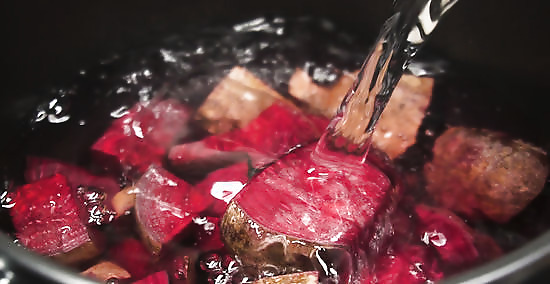
Place the cut beets into a saucepan and cover them with cold water. A small- to medium-sized saucepan will work best for this, because it will reduce the amount of water you need to add to cover the beets. Once you’ve placed the beets into your pan, pour in just enough water so the beets are completely covered. The more water you use, the longer you’ll have to cook the mixture to reduce down your food coloring.
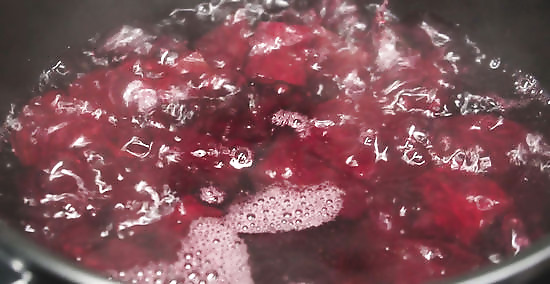
Bring the mixture to a boil over medium-high heat. Place the saucepan on a burner on your stove and turn it to medium-high until the water starts to bubble vigorously. Occasionally stir the beets with a long-handled spoon so they don’t stick to the bottom of the pan. It should take about 5-10 minutes for the water to come to a boil, depending on the size of the pan you’re using. Be careful not to burn yourself as the water is boiling! If you have to move the saucepan, use a pot holder, especially if the pan has a metal handle. If your stove settings are numbered from 1-10, medium-high heat is about a 6 or 7.
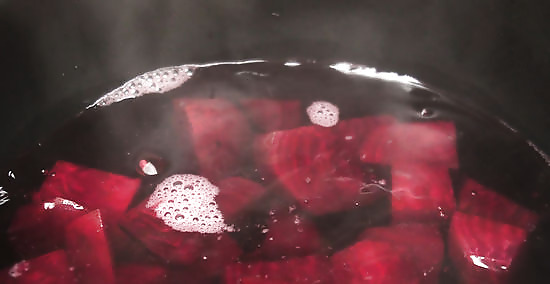
Simmer on medium-low heat until the beets are tender and the liquid is reduced. Once the beets reach a vigorous boil, turn the heat down to medium-low. Simmer the mixture until the beets are tender and the water is red, and there’s only about ⁄4 cup (59 mL) of liquid left in the bottom of the saucepan. This should take about 20 minutes, but it’s best to go by the volume of liquid, rather than the amount of time that has passed. Medium-low heat is about a 3-4 on a scale of 1-10. To test whether the beets are tender, pierce them with a fork. If the fork slides through easily, the beets are ready.
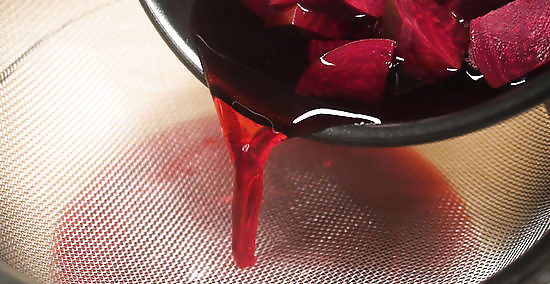
Strain the liquid through a fine-mesh strainer. Place a strainer over a bowl or a cup, then carefully pour the beets into the strainer. If you’d like, you can press the beets with the back of your spoon to ensure you get all the liquid out of them. The red water that collects in the cup or bowl is your all-natural red food coloring! Dye made from beets doesn't have a strong flavor, although it may add a little earthiness to whatever you cook. Replace commercial food dye with about the same amount of your beet dye for desserts like red velvet cake or to dye buttercream frosting for decorating cakes, cupcakes, and cookies! Be careful pouring your dye, as the beets and the liquid will be very hot! If the saucepan has a metal handle, use a pot holder when you pick it up. If you don’t have a strainer, line a colander with a coffee filter and pour the liquid through that, instead. The coffee filter will help catch any beet pieces that would be small enough to slip through the holes in the colander.
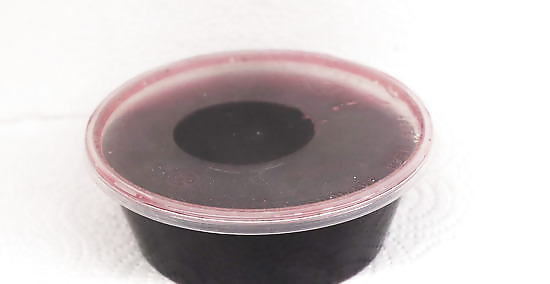
Store the liquid in an airtight container in the fridge for up to a week. Since your food coloring is made from a vegetable, it won’t keep indefinitely. Place it in a container with a tight-fitting lid and keep it in the refrigerator until you use it. Discard any leftover food coloring after about a week. Keep in mind that the beet juice may dye the container you're using, especially if it's made of plastic.
Trying Other Natural Food Dye Techniques
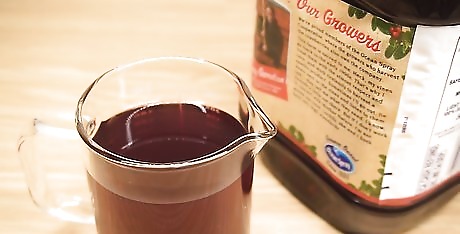
Use pomegranate juice in place of food coloring. Pomegranate juice will produce a deep purple-red color, and it will add a slight flavor of berries to your food. You can either purchase pre-made pomegranate juice, or you can make your own by blending, then straining the seeds. If you purchase commercially-produced pomegranate juice, ensure that it’s free of any other additives, as this will probably dilute the final color. Did You Know? You can make natural food coloring in almost any color you can imagine! For instance, you can use carrots to make orange, spinach to make green, and red cabbage to make purple dye! Depending on the concentration of the juice, you'll probably need to use a little more pomegranate juice than you would food dye. If you need a more concentrated color, try reducing the juice in a saucepan on the stove.
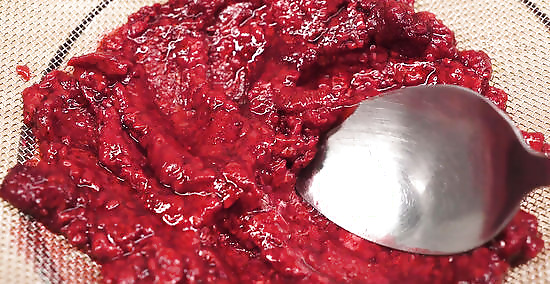
Crush raspberries or strawberries and strain out the juice. Red berries can also be used to produce all-natural food coloring, although typically you’ll get more of a pinkish hue than a true red. Place raspberries or strawberries into a strainer and mash them with the back of a spoon. Then, use the liquid in place of food coloring in your favorite recipes. Berries will produce a much lighter color than commercial food coloring, and they add a strong fruit flavor to your food. You may have better results if you keep the flavor in mind as you're adding the berries to your dish, rather than the final color. This food coloring is best used in desserts that will complement a berry flavor. For instance, if you use raspberries to color cake icing, it would probably pair nicely with chocolate cake.
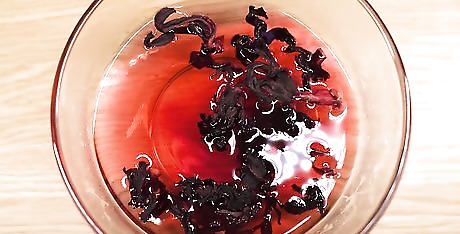
Steep dried hibiscus flowers in hot water for a floral red dye. If you can find dried hibiscus flowers, try placing 2 tbsp (5 g) of the flowers in 1 cup (240 mL) of steaming hot water for about 5 minutes. The color in the flower will leech into the water, creating a soft red dye with a subtle tart, floral flavor. You can often find dried hibiscus flowers in stores that specialize in Mexican, Indian, or Latin American ingredients. They may be labeled as sorrel or flor de Jamaica. If you can find hibiscus herbal tea with no added ingredients, you can steep that to get red food dye, as well. However, depending on the color of the flowers that were used in the tea, the result may be more pink or orange, rather than red. Use a similar amount of this dye as you would if you were using commercial dye. The color may be a little lighter, so add more if needed.

















Comments
0 comment